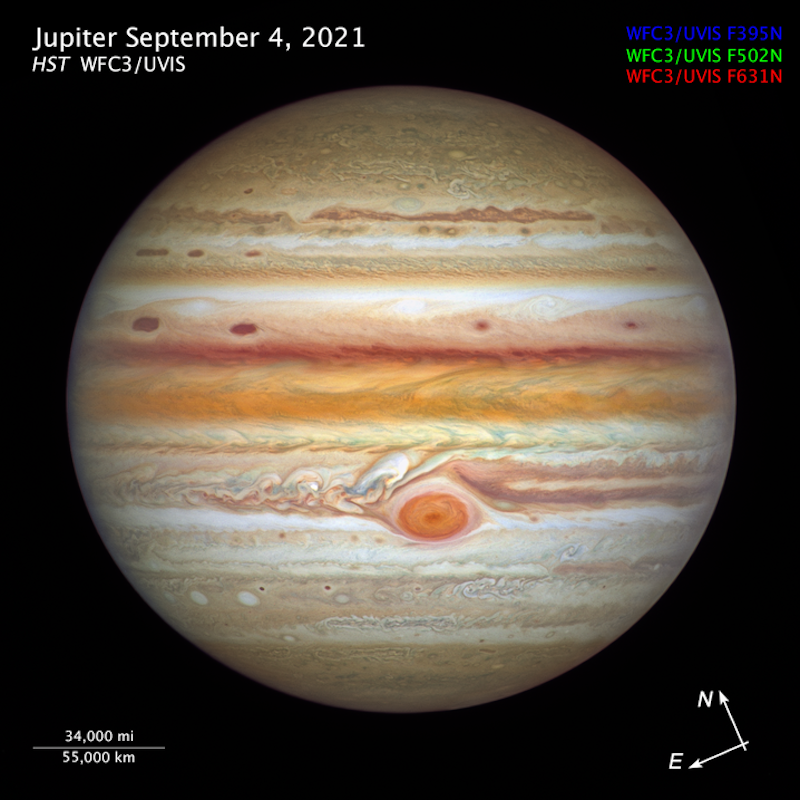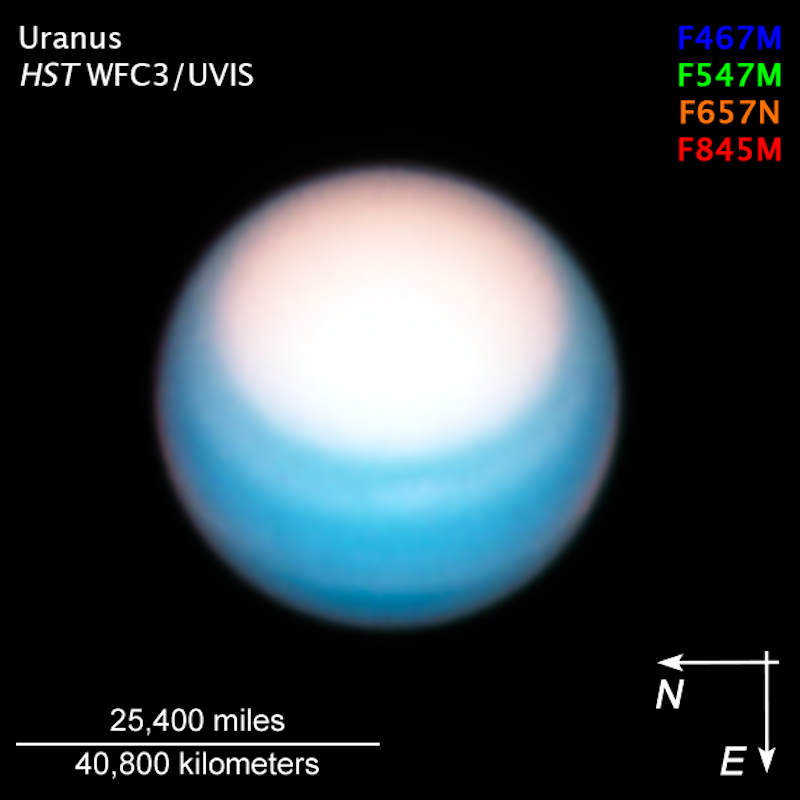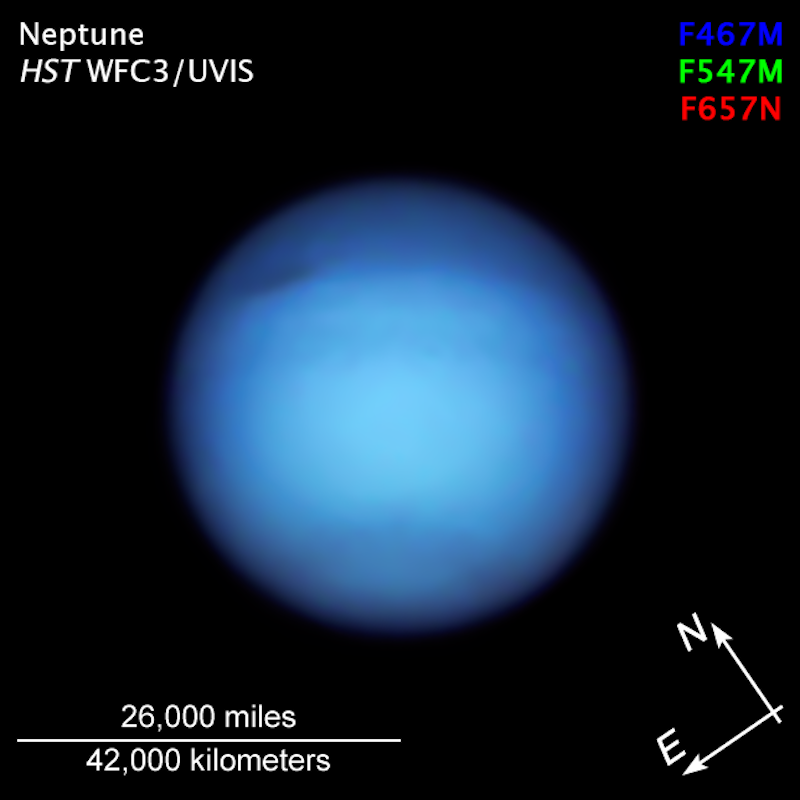
The gas and ice giants in our sun’s outer solar system are beautiful and mysterious worlds. At the moment only Jupiter is host to a visiting spacecraft from Earth, called Juno. But the Hubble Space Telescope has continued to keep a close eye on these outer worlds. On November 18, 2021, NASA released the latest stunning Hubble images of Jupiter, Saturn, Uranus and Neptune.
These annual observations, known as Hubble’s Grand Tour, highlight these exotic worlds and monitor changes in their turbulent, swirling atmospheres.
EarthSky 2022 lunar calendars now available! They make great gifts. Order now. Going fast!
Hubble’s Grand Tour: Next best to being there
The 1970s and 1980s saw visits to these distant worlds by Pioneer 10 and 11 and Voyager 1 and 2. Since then, there have only been return missions to Jupiter and Saturn: Galileo, Juno and Cassini. The best images we have of Uranus and Neptune are still those from Pioneer and Voyager.
However, the images from Hubble are still very good and, indeed, are the next best thing to being there. Even though all four planets are incredibly distant, Hubble can still show amazing detail in their atmospheres.
Hubble monitors these outer planets annually, as part of the Outer Planets Atmospheres Legacy program (OPAL). These global views help scientists track changes in their storms, winds and clouds on a yearly basis.
Lets’s look at what this year’s images can tell us about each planet.
Jupiter: Storms and more storms
Jupiter is the largest of the giant planets, and its deep atmosphere is constantly in turmoil with unending storms. This includes, of course, the famous Great Red Spot. Hubble captured these storms in striking detail on September 4, 2021. This year, scientists saw that Jupiter’s equatorial zone has remained a deep orange color. Previously, observations showed the atmosphere in this region to change from white or beige. This year, however, the orange color seems to be persisting a lot longer instead of reverting back to the blander colors.
Several new storms appear in the new images. They are nicknamed barges, a term first used by scientists during the old Voyager flybys of Jupiter. These cyclonic vortexes look like elongated brownish cells. While some have distinct edges, other are more fuzzy in appearance.

As Amy Simon of NASA’s Goddard Space Flight Center noted:
Every time we get new data down, the image quality and detail in the cloud features always blow me away. It strikes me when I look at Jupiter, in the barges or in the red band right below, you can see cloud structures that are clearly much deeper. We’re seeing a lot of structure here and vertical depth variation.
Saturn’s hexagon and colorful bands
Saturn’s iconic north polar hexagon is one of the most amazing sights in the solar system. Hubble’s new images taken on September 12, 2021, show it clearly. In contrast, it was more difficult to discern in the images from last year. The hexagon is a stunning feature, seemingly out of place with its well-defined, almost artificial-looking edges. Voyager 2 discovered the hexagon in 1981.
In the center of the hexagon is a giant cyclone. This cyclone is 1,240 miles (2,000 km) across with cloud speeds as fast as 330 miles per hour (150 meters per second). The sides of the hexagon itself are an incredible 8,600 miles (13,800 km) long.
This year’s images also show rapid and striking color changes in the planet’s atmospheric bands in the northern hemisphere. In the southern hemisphere, it is now winter, with the south pole showing a bluish hue.

According to Michael Wong of the University of California, Berkeley:
This is something we can best do with Hubble. With Hubble’s high resolution, we can narrow things down to which band is actually changing. If you were to look at this through a ground-based telescope, there’s some blurring with our atmosphere, and you’ll lose some of those color variations. Nothing from the ground will get visible-light images as sharp as Hubble’s.
Springtime on Uranus’ polar hood
It is springtime right now in Uranus’ northern hemisphere. The planet’s famous polar hood shines as bright as ever in the new images from October 25, 2021. This is due to more ultraviolet radiation being absorbed from the sun. Likewise, there are also changes in the concentration of methane gas and the characteristics of haze particles, as well as atmospheric flow patterns, in the polar hood.
Interestingly, the southernmost edge of the polar hood always remains at a latitude of 43 degrees. Scientists think this is due to a jet stream in the atmosphere.

Neptune’s Dark Spot
One of the most intriguing features on Neptune is its Great Dark Spot, reminiscent of Jupiter’s Great Red Spot. Hubble observed Neptune on September 7, 2021, seeing not only the dark spot, but a darker than usual northern hemisphere as well. A dark, elongated circle in the atmosphere surrounds the planet’s south pole.
Last year, astronomers observed a large dark spot possibly change direction, and they aren’t completely sure why. A smaller dark spot, “dark spot jr.,” also seemed to have broken off the larger spot.
Like Uranus, the atmospheric bands on Neptune aren’t as prominent as those on Jupiter and Saturn, but they are there. Hubble also saw a few bright clouds in its latest observations.
Hubble is, of course, well known for providing breathtaking views of the universe at large. Needless to say, however, it also brings us closer to fascinating worlds right here in our own solar system.

Bottom line: NASA has released stunning new images of Jupiter, Saturn, Uranus and Neptune from the Hubble Space Telescope. These annual observations are called Hubble’s Grand Tour of the outer solar system.











